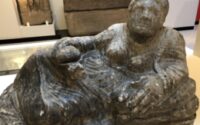An Etruscan Lady in York: Investigating Antiquarian Collections in the Yorkshire Museum
- Date
- 21 Jun 2023
- Start time
- 2:30 PM
- Venue
- Yorkshire Museum
- Speaker
- Professor Maureen Carroll, University of York

An Etruscan Lady in York: Investigating Antiquarian Collections in the Yorkshire Museum
Prof Maureen Carroll, Department of Archaeology, University of York
Maureen Carroll from the University of York talks about the archaeological context and significance of a stone funerary sculpture from Etruscan Italy in the Yorkshire Museum. Her research shows that it was acquired on the Grand Tour and later donated to the Yorkshire Philosophical Society.
Lecture to be held in the Tempest Anderson Lecture Theatre, Yorkshire Museum,
YO1 7DR at 2.30pm
ALL WELCOME. Please note this lecture follows the YPS AGM at 2pm – doors open for non members at 2.20pm.
Image credit YORYM_2021_7-1© York Museums Trust (Yorkshire Museum).
Member’s report
Professor Carroll’s research focus is on death and burial, mostly in Italy. One day while in the Yorkshire Museum she noticed ‘a forlorn sculpture of an Etruscan lady’, in the gallery dedicated to Roman York. It sat amongst York finds: tombstones and many grave goods. Immediately she thought ‘That’s not Roman and it is not from York’. The label on its podium read ‘Lady of leisure’. Professor Carroll contacted Lucy Creighton in the museum and an investigation followed.
The sculpture is the lid of a stone coffin of a lady reclining and was originally set up in a family tomb in Etruria. Estruscans lived in north central Italy during the 3rd C BCE and were eventually conquered by Rome. A decorated tomb lid with the box were produced and sold separately. By 1st CBCE this kind of monument was no longer used.
Closer investigation
Under ‘Knowledge Exchange Funding Scheme’ a grant was obtained to clean and remove grit and grime from the sculpture. It was also hoped close examination might find traces of original pigments. A series of digital images was collected and a 3DS model of the entire object assembled. The dirt and grime were difficult to remove, but the sculpture proved to be carved from stone with pale grey veins. (Many Etruscan funerary monuments are made of fired clay.)
The woman was shown wearing skullcap, belt, tunic and mantle with decorative features. In one hand she holds a pomegranate (not a lamp as originally thought). The whole investigation was recorded on video. No traces of pigment were discovered. Similar Tuscan coffin lids are brightly painted with a huge range of colours.
How did it get to York?
The next phase of the project was to investigate the archives of YPS which showed that the Etruscan lady donation dated to 1883 a time when antiquities flowed into the UK from all over Europe. YPS records showed it was donated by W Atkinson and originally purchased in Rome.
Who are Atkinsons? Peter Atkinson was a famous York architect, assistant to John Carr, and produced two sons JB and W Atkinson. The firm became the most prolific architects in York, based in Micklegate near Ouse Bridge. The family then moved to 5 Driffield Terrace, 1851-1861. Further research led to the discovery of the passport of John Bownas Atkinson, a passport issued by France that showed he stayed in Florence and Rome while on the grand tour 1829-31. John Bownas Atkinson is thought to have passed the sculpture to his brother William who eventually gave it to the YPS.
Maureen finished by quoting a 19th C Italian commenting on the trade in antiquities: ‘The English take away everything but not things of value’.
All in the Tempest Anderson Hall were grateful for this generous attitude and are pleased to see this sculpture better researched, understood and on show in the Yorkshire Museum. A great lecture.
Andrew K G Jones